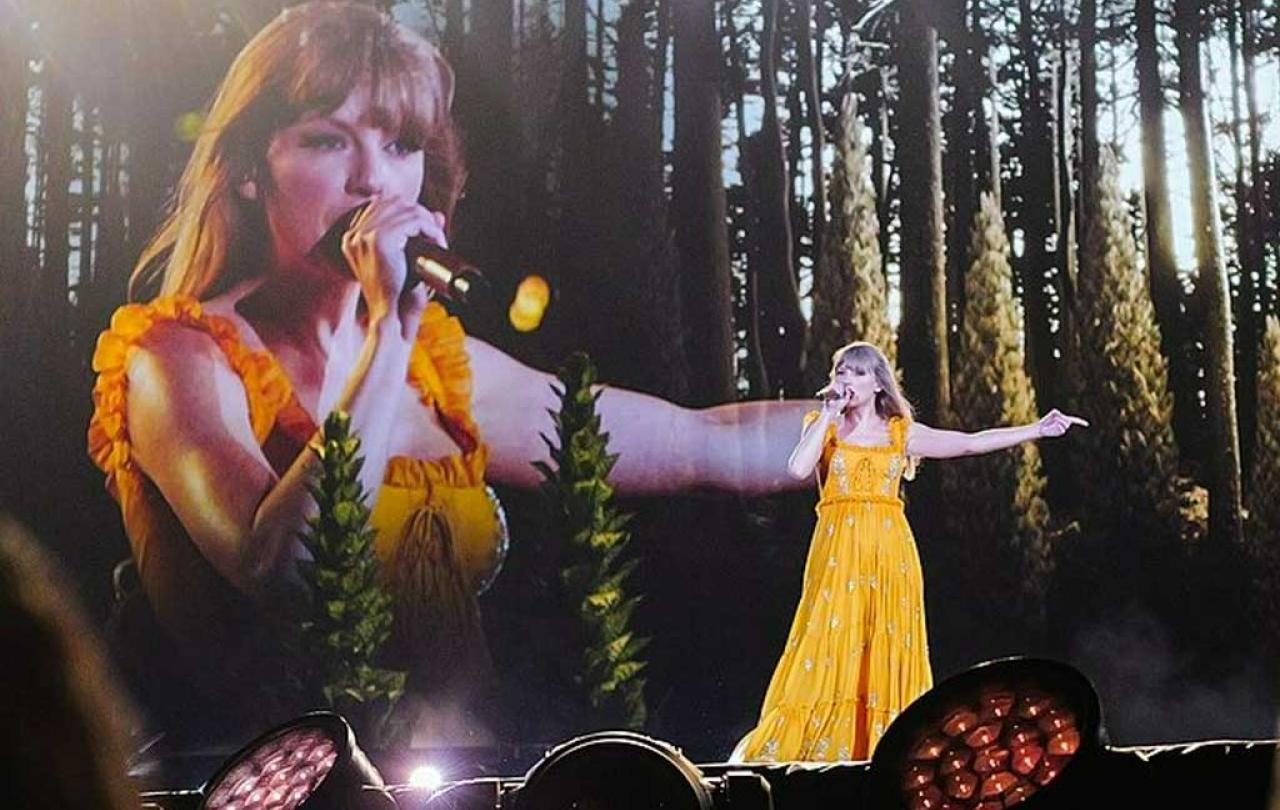
If you have been paying any attention to Taylor Swift’s most recent tour, you will know why the last several months have been termed The Summer of Taylor Swift. The artist has traveled across America, boosting economies en route, and filling stadiums with contagious happiness.
I hadn’t realized the enormous impact Swift had made on entire cities until I was walking downtown Seattle earlier this summer for a Mariners baseball game. While walking from my car to the stadium I encountered an endless sea of Taylor Swift fans waiting outside the stadium in the early afternoon for her show that would begin that evening. I had heard about Taylor Swift before, had listened to her music, but seeing what I saw that day told me something more profound about her and something about us as human beings.
But what I saw on the downtown streets of Seattle leading up to Taylor Swift’s concert was different.
In recent history, we have seen different artists such as The Rolling Stones and AC/DC elicit strange (and frankly awkward) adulation where people throw their clothes onto the stage. U2 concerts have been hailed as a religious experience in which stadiums become cathedrals. And more recently, Justin Bieber gave many “Bieber Fever.”
But what I saw on the downtown streets of Seattle leading up to Taylor Swift’s concert was different. I’ve been trying to pinpoint what it was exactly that struck me that day. People of all ages packed into surrounding streets in Taylor Swift attire, countless groups lustily singing her songs, cars and vans marked up with Taylor Swift song lyrics. There was a unity, a togetherness and distinct humanity to it all. The feeling was more akin to a spiritual revival than merely a big stadium concert rolling into town.
I remember coming back home that evening and texting friends to see what they made of it. My question was: “What is it about Taylor Swift that has enabled her to connect with so many?” The answers I received all struck the same notes: A Taylor Swift concert was the best they had ever experienced. But more than the concert, it’s the vibe, the pure joy and happiness that you experience with everyone at the concert. There is something about her that makes people feel happy. And although she is a stratospheric star, she has deliberately made a point of seeming like the girl next store. People think and feel that she is their friend. She is relatable.
If you are a Taylor Swift fan, you already know this. But as these thoughts about Taylor Swift rumbled through my brain for weeks after that experience, they took on a greater meaning during a lunch meeting I had with a friend back from college for the summer. Midway through our time together he asked me, “How do you deal with people who are fake?” The pensive look on my face revealed that I wasn’t exactly sure what he was asking, so he sharpened the question: “How do you deal with people who are hypocrites?”
I now understood what he was getting at. He gave a few examples of friends and leaders around him who had acted in hypocritical ways. He saw through it. Although he had moved on from those relationships, the jagged edges of hypocrisy still dug into him. They hurt. My friend was asking me how or if it’s even possible to trust in people who let you down.
The truth is, I’ve lost count of the conversations I’ve had with people who have asked or expressed the same question. And yet, when my friend asked me this question, I wasn’t sure what to say.
I offered just one thought: “What if the antidote to hypocrisy is the real thing? As in, what if the medicine for the disingenuous and fake is seeing a life that is genuine and real—a person who is true, honest, who lives a life of integrity?
And in Taylor Swift, we’ve found a companion who knows the struggle of life and invites us to join her.
This is where my mind came back to Taylor Swift and why it is that millions of us feel a real connection to her. The answer is nuanced, to be sure, but I wonder if part of it has to do with the fact that when we see or hear Taylor Swift, we experience a person who comes across as real. Perhaps more than in recent memory, we as a society have a low tolerance for BS. Yet, despite our abhorrence for the fake, our attraction to the real and authentic has grown just as strongly.
Enter Taylor Swift. Among other qualities, Swift is not a fake. Isobel Jones, a cradle Swiftie, recently explained this to me:
‘Taylor Swift isn’t fake because we’ve known her since she was 14, she gave all of herself to us, in her songs, in her interactions with fans, sending her coat to a fan who loved it (During the RED era; Swift would have been 22ish). She’s one of the first Tumblr gen artists who has consistently connected with fans and grown up with them, proving her consistency.’
We can relate to the words in Swift’s songs. Her lyrics of sadness, anger, hope, and grace connect with us. She touches the human spirit, not necessarily because we’ve been through the exact same kind of struggles, but because we are all human beings trying to figure out how to cope with hard things in life, own up to our shadows and weaknesses and still engage our journey in life. And in Taylor Swift, we’ve found a companion who knows the struggle of life and invites us to join her.
In our age of loneliness and disintegrating relational bonds, I believe the message of Taylor Swift transcends her concerts and songs. She carries a message for us, a reminder of what we need as human beings. Truth, integrity, authenticity. We don’t necessarily expect people to be perfect, but we need an honesty in our relationships about who people really are, whether that is the good or the bad. Just please, whatever you do, don’t be a hypocrite.
Wounds from hypocrisy can be hard to recover from. As a person of faith, I have experienced first-hand and have heard myriad stories of hypocrisy in the church. There is indeed much to be disheartened by in our world, and far-too-often within church walls. But in my more sober-minded moments when I am looking for lasting and healing solutions, I encounter a balm for my pain when I focus on the core and centre of the Christian faith.
At its heart, Christianity goes beyond offering merely propositional prescriptions for the pain that paralyses us. Instead, hope is offered supremely in and through the person of Jesus Christ, God-in-flesh. Within Christ is a truth that rolls throughout the whole of sacred Scripture. It is the beautiful message that there is a God who can be trusted. We can trust him because he is real, he lived in our world of pain and hypocrisy, and he conquered its power. We might carry scars for the rest of our lives, but Christ’s life tells us that there will come a point, before we die or after, when he will heal the deepest of our wounds. He can be trusted, not because he makes everything in life work out the way we want it to, or because we will never experience pain, but because in Christ, we’ve found the one who knows the way through it.
There’s also a challenge here for those who follow Christ and it is simply to reflect his character of truth, love, and beauty in how we live thereby opening up a world into which people actually want to inhabit.
Recovering from being hurt by hypocrisy can be a long and hard road to travel. A recent conversation with a friend reminded me of how difficult that is while my experience of Seattle bubbling with Taylor Swift happiness provided a signpost of hope. And behind all of this I am made to wonder, more than I can ever recall, whether faith in Jesus Christ can help steer us in the right direction, if we are willing to engage who he was and the life into which he invites us.





